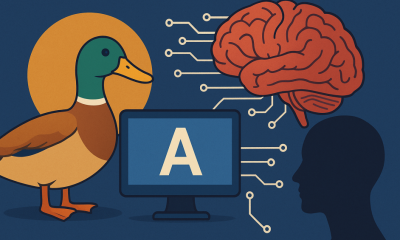Artificial Intelligence
LLMs’ Memory Limits: When AI Remembers Too Much

In recent years, large language models (LLMs) have become increasingly proficient at generating human-like text across various applications. These models achieve their remarkable abilities by training on vast amounts of publicly available data. However, this capability also brings certain risks. Models may inadvertently memorize and expose sensitive information such as private emails, copyrighted text, or harmful statements. Balancing the benefits of useful knowledge with the risks of harmful recall has become a key challenge in the development of AI systems. In this blog, we will explore the fine line between memorization and generalization in language models, drawing on recent research that reveals how much these models truly “remember.”
Balancing Memory and Generalization in LLMs
To better understand memorization in language models, we need to consider how they are trained. LLMs are built using large datasets of text. During the training process, the model learns to predict the next word in a sentence. While this process helps the model understand the structure and context of language, it also leads to memorization, where models store exact examples from their training data.
Memorization can be helpful. For example, it allows models to answer factual questions accurately. But it also creates risks. If the training data contains sensitive information, such as personal emails or proprietary code, the model might unintentionally expose this data when prompted. This raises serious concerns about privacy and security.
On the other hand, LLMs are designed to handle new and unseen queries, which require generalization. Generalization allows models to recognize broader patterns and rules from the data. While it empowers LLMs to generate text on topics they weren’t explicitly trained on, it can also cause “hallucination” where the model may produce inaccurate or fabricated information.
The challenge for AI developers is to strike a balance. Models must memorize enough to provide accurate responses but generalize enough to handle new situations without compromising sensitive data or producing errors. Achieving this balance is critical for building safe and reliable language models.
Measuring Memorization: A New Approach
Measuring how well a language model understands context is not a simple task. How do you tell if a model is recalling a specific training example or simply predicting words based on patterns? A recent study proposed a new approach to evaluate this problem using concepts from information theory. Researchers define memorization by how much a model can “compress” a specific piece of data. Essentially, they measure how much a model can reduce the amount of information required to describe a piece of text it has seen before. If a model can predict a text very accurately, it likely has memorized it. If not, it might be generalizing.
One of the key findings of the study is that transformer-based models have a limited capacity for memorization. Specifically, they can memorize about 3.6 bits of information per parameter. To put this in perspective, imagine each parameter as a small unit of storage. For these models, each parameter can store roughly 3.6 bits of information. Researchers measure this capacity by training the models on random data, where generalization isn’t possible, so the models had to memorize everything.
When the training dataset is small, the model tends to memorize most of it. But as the dataset grows larger than the model’s capacity, the model starts to generalize more. This happens because the model can no longer store every detail of the training data, so it learns broader patterns instead. The study also found that models tend to memorize rare or unique sequences, like non-English text, more than common ones.
This research also highlights a phenomenon called “double descent.” As the size of the training dataset increases, model performance initially improves, then reduces slightly when the dataset size approaches the model’s capacity (due to overfitting), and finally improves again as the model is forced to generalize. This behavior demonstrates how memorization and generalization are intertwined, and their relationship depends on the relative sizes of the model and the dataset.
The Double Descent Phenomenon
The double-decent phenomenon provides an interesting insight into how language models learn. To visualize this, imagine a cup being filled with water. Initially, adding water increases the level (improves model performance). But if you add too much water, it overflows (leads to overfitting). However, if you keep adding, eventually, the water spreads out and stabilizes again (improves generalization). This is what happens with language models as dataset size increases.
When the training data is just enough to fill the model’s capacity, it tries to memorize everything, which can lead to poor performance on new data. But with more data, the model has no choice but to learn general patterns, improving its ability to handle unseen inputs. This is an important insight, as it shows that memorization and generalization are deeply connected and depend on the relative size of the dataset and the model’s capacity.
Implications for Privacy and Security
While the theoretical aspects of memorization are interesting, the practical implications are even more significant. Memorization in language models poses serious risks to privacy and security. If a model memorizes sensitive information from its training data, it could leak this data when prompted in certain ways. For example, language models have been shown to reproduce verbatim text from their training sets, sometimes revealing personal data like email addresses or proprietary code. In fact, a study revealed that models like GPT-J could memorize at least 1% of their training data. This raises serious concerns, especially when language models can leak trade secrets or keys of functional APIs that contain sensitive data.
Moreover, memorization can have legal consequences related to copyright and intellectual property. If a model reproduces large portions of copyrighted content, it could infringe on the rights of the original creators. This is especially concerning as language models are increasingly used in creative industries, such as writing and art.
Current Trends and Future Directions
As language models become larger and more complex, the problem of memorization becomes even more pressing. Researchers are exploring several strategies to mitigate these risks. One approach is data deduplication, where duplicate instances are removed from the training data. This reduces the chances that the model will memorize specific examples. Differential privacy, which adds noise to the data during training, is another technique being investigated to protect individual data points.
Recent studies have also examined how memorization occurs within the internal architecture of models. For example, it has been found that deeper layers of transformer models are more responsible for memorization, while earlier layers are more critical for generalization. This discovery could lead to new architectural designs that prioritize generalization while minimizing memorization.
The future of language models will likely focus on improving their ability to generalize while minimizing memorization. As the study suggests, models trained on very large datasets may not memorize individual data points as effectively, reducing privacy and copyright risks. However, this does not mean that memorization can be eliminated. More research is required to better understand the privacy implications of memorization in LLMs.
The Bottom Line
Understanding how much language models memorize is crucial for using their potential responsibly. Recent research provides a framework for measuring memorization and highlights the balance between memorizing specific data and generalizing from it. As language models continue to evolve, addressing memorization will be essential for creating AI systems that are both powerful and trustworthy.












